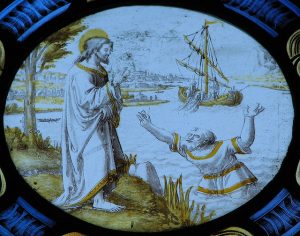Revised Common Lectionary Reflection, Proper 14, Year A
Click here for the readings
August 13, 2023*
But when the disciples saw him walking on the sea, they were terrified, saying “It is a ghost!” And they cried out in fear. Matthew 14:26
Between the feeding of the 5,000+ and a brief episode of healing, Matthew’s gospel gives us an interlude of fear and wonder accompanied by chaos and impetuousness in the lives of Jesus’ closest followers. Bring on the Tums! This kind of discipleship can truly make the average disciple “see” sick and world weary.
In this week’s gospel, Jesus has sent the disciples across the lake ahead of him so that he can finally get some alone time in prayer. In sending them across the lake Jesus sends them into danger. In the ancient world, the sea (or any large body of water) represents chaos. Recall the storm (in chapter 8) that the disciples encountered while crossing the lake from the Jewish side to the Gentile side. Going through chaos into unknown and/or hostile territory makes for some fine drama, unless of course you are the one who is experiencing it.
This week brings added excitement when the disciples see Jesus walking toward them on the water and mistake him for a ghost. They are absolutely terrified and cannot see the Lord right in front of their eyes. Even after Jesus speaks, identifies himself and tells them not to fear but to be encouraged, they still cower. Bold Peter is the first one to make a bargain with this strange  visage: If it’s you then command me to come to you. Jesus responds with one word: “Come.” It’s not clear whether it was said as command or invitation, but Peter responds, and things are going swimmingly until he realizes the impossibility of what he’s doing and starts to sink. The rest of the story is simple. Peter calls out for help, Jesus rescues him, the two get in the boat, the chaos calms, the disciples worship and decide that Jesus indeed must be God’s son.
visage: If it’s you then command me to come to you. Jesus responds with one word: “Come.” It’s not clear whether it was said as command or invitation, but Peter responds, and things are going swimmingly until he realizes the impossibility of what he’s doing and starts to sink. The rest of the story is simple. Peter calls out for help, Jesus rescues him, the two get in the boat, the chaos calms, the disciples worship and decide that Jesus indeed must be God’s son.
Be sure to note the very end of the chapter, verses 34-36, that are not included in the Lectionary reading. The verses tell what happens on the other side of the lake, how the people recognize Jesus and the sick are healed simply by touching the edge of his clothes. I wonder how the disciples felt about that, since they had not only just failed to recognize their Rabbi but also been terrified by the sight of him.
So what are we to make of this story as modern disciples? Do we fail to recognize Jesus when the going gets tough and the storms of life rage about us? What “other side” of the metaphorical lake does Jesus send us to, and what chaos ensues? Are we ever actually afraid of Jesus? I wonder if we might just be terrified that this Jesus, still loose in the world today, really is going to do something through us and with our paltry, rag-tag gifts and pitiful efforts. Just what madness might really come of all this (and what will it cost us)? Oh, and then there’s always the distinct possibility that the folks on the other side, those others and strangers, will recognize Jesus and make a mess of our neatly organized party.
I know from personal experience that I do have a tougher time seeing Jesus when chaos closes in and things aren’t going so hot. Like Peter and the others, I am too easily consumed  by my own fears and insecurities. Me, walk on water? Right! I’m not even sure I can walk on ice without falling and hurting myself.
by my own fears and insecurities. Me, walk on water? Right! I’m not even sure I can walk on ice without falling and hurting myself.
And here’s the grace. There is no storm of uncertainty, no chaos of conscience, no dark waters of despair that will prevent Jesus from responding to my frantic and fading cry for salvation. Indeed, Jesus is strong to save, and as Paul says in the epistle lesson, “…Everyone who calls on the name of the Lord shall be saved” (Romans 10:13). We are not outside of Jesus’ reach — even me and you and all of little faith who would bargain with God in our moments of doubt. Like those first disciples with their faltering faith and stubborn doubt, we keep on putting one foot after the other. We follow Jesus, trusting the promise that all who call on his name, who touch the hem of his Word, will be saved.
In Worship
We’re all in this together as worshiping communities. Even the for our worship space, “nave,” is derived from the Latin for “ship.” If we all pull together in the same direction, the storms of life, the crises of faith, and the clash of culture will not cause us to flounder. Yes, like the disciples Jesus has sent us into the rough seas of this world to reach out to those on the other side of whatever and whomever. Consider purchasing small wooden discs from a craft store. On one side either stamp or print a sticker of a small boat. On the other side stamp or print a sticker of the Ichthys (Jesus fish symbol). Give each person one to take with them into the world as a reminder that the church is the boat and Jesus the one who pilots us and guides us through life.
Consider singing the hymn “Jesus, Savior Pilot Me” this Sunday. You might even use it to frame the sermon.
With Youth
God’s math doesn’t work out like human math, and it’s certainly not always compatible with human logic. In reality, it’s always better. This week’s gospel lesson can give us a good “equation” for the nature of Jesus. Write this equation on a white board or large sheet of paper: Jesus > Chaos + Fear + Doubt. In fact, no matter what we put on the side of the equation opposite Jesus, he will always be greater than the sum of anything humankind can come up with. Invite youth to explore the kinds of chaos, confusion, fears, doubts, and pain that life’s storms a hurling at them and their friends. How might they experience Jesus as the one who stills life’s storms, and how might they share that with others?
An alternate activity is to create a video to illustrate Psalm 85:8-13. Especially in light of current world events, these verses have some great visual potential. How might one illustrate the idea of righteousness and peace kissing? How might faith look like springing from the ground? What music might best accompany the images?
With Children
Beautiful Feet?
Ask the children if they’ve ever read Dr. Seuss’ Foot Book, and bring a copy if you have one. Children may be familiar with the words of this classic. How many kinds of feet do we meet? Big feet. Little feet. Stinky feet. Hairy feet. Dirty feet. Left feet. Right feet. Yes, how many feet we meet. Ask children if they’ve ever met anyone with beautiful feet? We don’t often describe feet as beautiful in our culture. We tend to cover our feet if we don’t like the way they look, and we generally don’t to have our feet touched. In the epistle lesson today, Paul quotes Isaiah 52:7 in verse 15, “How beautiful are the feet of those who bring good news!” Ask the children who brings good news? Affirm their answers but be sure to tell them that THEY bring good news by telling others about Jesus. That makes their feet beautiful. Consider creating a simple coloring sheet with Romans 10:15 written on it at the top and on the bottom “My feet are beautiful because I tell others about Jesus.” Leave room in between for the children to trace their own feet. Either give them stickers to decorate their “feet” or encourage them to color them. Consider posting the beautiful feet sheets somewhere in the church building for all to see.
Photos: Binny V A, markheybo, and Wolfgang Staudt, Creative Commons




Thanks, Sharron! I like the math equation idea. I think I’m going to hand out sticky notes with each bulletin, and invite people to write on it their greatest fear. During communion, they can bring it up and stick it on the white board where I’ll have written Jesus > chaos + fear + doubt + … all their fears.
That’s a great idea, Caitlin! Hope it worked well for you. Peace!